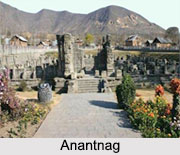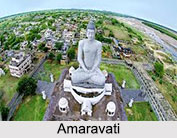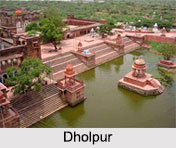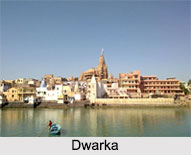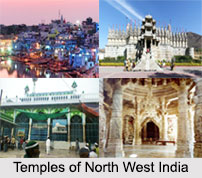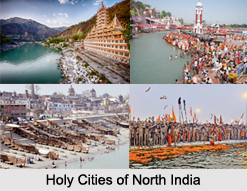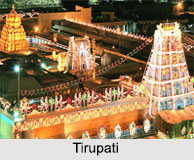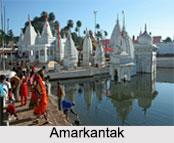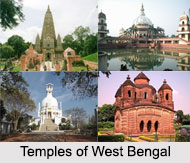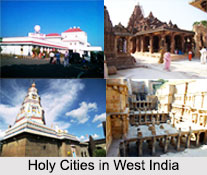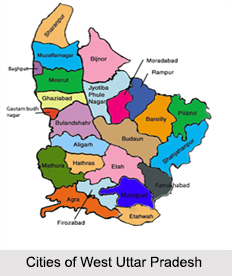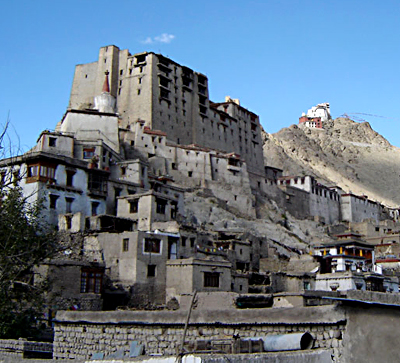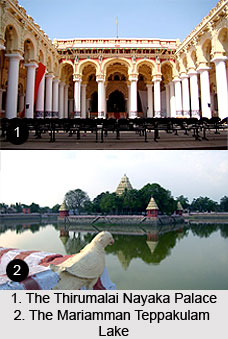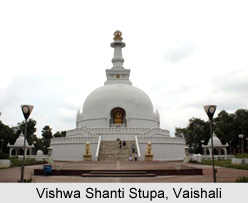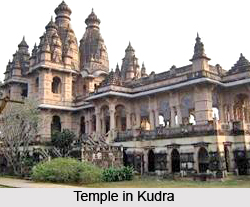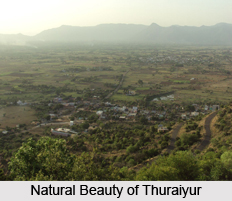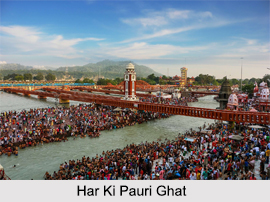Introduction
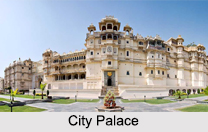 The numerous magnificent palaces in Udaipur stand as a testament to its rich cultural history and heritage. In erstwhile British India, Udaipur used to be the capital city of the kingdom of Mewar. The forts and palaces built during this time represent the Rajput style of architecture and are now a major tourist attraction. Also known as the White City of India, Udaipur"s white marbled Rajput palaces stand tall around Lake Pichola.
The numerous magnificent palaces in Udaipur stand as a testament to its rich cultural history and heritage. In erstwhile British India, Udaipur used to be the capital city of the kingdom of Mewar. The forts and palaces built during this time represent the Rajput style of architecture and are now a major tourist attraction. Also known as the White City of India, Udaipur"s white marbled Rajput palaces stand tall around Lake Pichola.
The luxurious palaces of Udaipur tell stories of the glorious past and the lavish, elegant lifestyles of the royal families that lived here. Many of these grand palaces have been converted into heritage hotels and museums, so that they are more accessible to the locals and the tourists.
The city of Udaipur is a blend of sights, sounds and experiences, which have made it one of the top destinations for weddings and celebrations. The city is well connected to all the other major cities of India. The nearest airport being the Dabok Airport and the 2 railways stations are the Udaipur City railway station and the Rana Pratap Nagar railway station.
City Palace in Udaipur
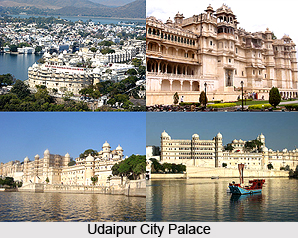 Built on the banks of Lake Pichola, the foundations of the City Palace Complex, Udaipur was laid by Maharana Udai Singhji when he decided to build a new capital for the Sisodia rulers of Chittorgarh, Rajasthan. Subsequent Maharanas later extended it to its present form, by adding several palaces and structures to the complex and yet retaining a surprising uniformity to the design. The palace is made of granite and marble and is built on a raised height and surrounded by crenellated fort walls.
Built on the banks of Lake Pichola, the foundations of the City Palace Complex, Udaipur was laid by Maharana Udai Singhji when he decided to build a new capital for the Sisodia rulers of Chittorgarh, Rajasthan. Subsequent Maharanas later extended it to its present form, by adding several palaces and structures to the complex and yet retaining a surprising uniformity to the design. The palace is made of granite and marble and is built on a raised height and surrounded by crenellated fort walls.
This palace is now a heritage building, showcasing the elements of Rajput culture and the arts. It also combines the elements of Chinese and European architecture and has a number of remarkable buildings of immense beauty, gardens and fountains, well planned and finely executed over the years. Also in the palace, there is the range of turrets, domes and arches to form a fascinating sight with the aesthetic beauty of their artwork.
The City Palace Complex is essentially a fortified city with massive walls enclosing a mini township within its folds. There are several gigantic gateways that lead to the City Palace Complex. But the famous entrance to the Palace complex is through the `Elephant Gate` or the `Hathi Pol` from the main road. Among the other gateways the Bara Pol and Tripolia Pol were significant in the olden days.
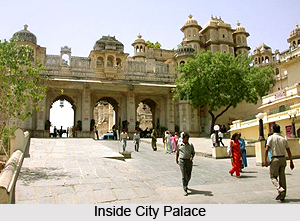
The biggest and most beautiful temple of Udaipur, the Jagdish Temple (1651A.D), where Lord Vishnu is worshipped can be seen here. The `Great Gate` or `Bara Pol` (1600A.D) on the northern end is the entrance to the first courtyard, which joins Tripolia or the `Triple Gate` (1725 A.D). There are eight carved marble arches or `Toranas`, between the two gates, under which the Maharanas would weigh themselves under this gate in gold and silver, and the value of their weight would in turn be distributed to the populace. It is also now the main ticket office.
Beyond the Tripolia there is an arena of marble arches, where various elephants were staged, since it was an elephant-fighting arena. There are also many gardens within the palace complex. The City Palace museum is then entered through the Ganesh Deori meaning the door of Lord Ganesh, which leads to the oldest part of the palace, `Raj Aangan` (Royal Courtyard-1571) which Maharana Udai Singh built in the 16th century. This is the very spot where Maharana Udai Singh met the sage who told him to find a city here. Its main part, along with its several Mahals is now preserved as a Museum that displays a large and diverse array of artifacts. Down from the entrance of the museum, is the armory museum exhibiting a huge collection of protective gear, weapons including the lethal two-pronged sword.
The Krishna Vilas has a rich and remarkable collection of miniature paintings depicting royal processions, festivals and games of the Maharanas.
The Mor Chowk is the peacock square and gains its name since unique glass mosaics of peacocks set in the wall, decorate it showing the three seasons: summer, winter and monsoon.
The Manak Mahal (Ruby Palace) has a lovely collection of glass & mirror work. It also has crystal and porcelain figures.
Bhim Vilas with Radha Krishna stories painted on the walls has a glass mosaic gallery, the `Suraj Gokhala`, with beautiful stained glasses and a panoramic view of the city below.
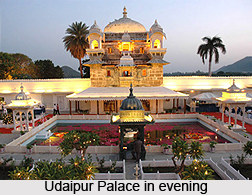
The Zenana Mahal, the queen`s quarters to the south and the `Dilkusha Mahal` (Palace of Joy) have frescoes and wall paintings and it leads to Lakshmi Chowk a beautiful white pavilion.
The Laxmi Vilas Chowk, an art gallery, houses a distinctive collection of Mewar paintings.
The Chini Chitrashala is famous for its Chinese and Dutch ornamental tiles, the latter of which has depiction of Biblical scenes including the flight to Egypt.
The Moti Mahal (Palace of Pearls) has lavish and beautiful mirror decor and the Sheesh Mahal (Palace of mirrors) has inlaid mirror work.
There is a Hawa Mahal and a Bari Mahal, which is a central garden with view of the city with a fine garden build on a 90 feet high natural rock formation.
The Amar Vilas, the highest point has exquisite hanging gardens with fountains, towers and terraces and a majestic view of the town and Lake Pichola.
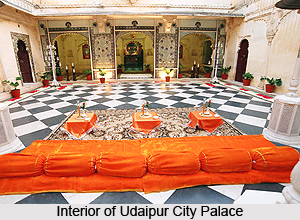 The Suraj Gokhada or the balcony of the sun is where the Maharana would grant public audiences mainly to boost the morale of the people in difficult times.
The Suraj Gokhada or the balcony of the sun is where the Maharana would grant public audiences mainly to boost the morale of the people in difficult times.
The palaces of Dilkhush mahal, Sheesh mahal, Moti mahal and Krishna vilas- were built in memory of a princess of striking beauty who poisoned herself to avert bloody battle for her hand by rival princess. Now the palace is housed with many antique articles, paintings, decorative furniture and utensils, which attracts thousands of visitors every day. Inside the separate palace enclosure, entered from the South of Badi Chowk, there are also the Shiv Niwas and Fateh Prakash Palace, which are now run as hotels.
Lake Palace in Udaipur
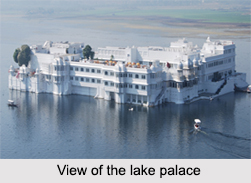 Lake Palace in Udaipur lies in the heart of Pichola Lake. It is located in the Jag Niwas Island. The Lake Palace was once the summer retreat of the Rajputs.Originally called Jag Niwas or Jan Niwas after its founder, Maharana Jagat Singh II, the Lake Palace is situated on the Jag Niwas Island in Lake Pichola. This white marbled palace was constructed to serve as a royal summer retreat for the Rajputs. A hint of Mughal architecture can be seen in the pal
Lake Palace in Udaipur lies in the heart of Pichola Lake. It is located in the Jag Niwas Island. The Lake Palace was once the summer retreat of the Rajputs.Originally called Jag Niwas or Jan Niwas after its founder, Maharana Jagat Singh II, the Lake Palace is situated on the Jag Niwas Island in Lake Pichola. This white marbled palace was constructed to serve as a royal summer retreat for the Rajputs. A hint of Mughal architecture can be seen in the pal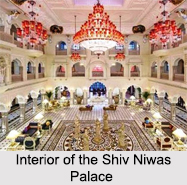 ace. The courtyards of the palace are lined with pillared terraces, columns, gardens and fountains. The rooms of the heritage hotel are decorated with arches and painted mirrors.
ace. The courtyards of the palace are lined with pillared terraces, columns, gardens and fountains. The rooms of the heritage hotel are decorated with arches and painted mirrors.
Spanning over 4 acres of land and consisting of 83 rooms and suites, the palace has now become a luxury 5 star hotel. It now operates under the Taj Hotels Resorts and Palaces banner. The palace was used as shooting place for several movies like The Tiger of Eschnapur, The Fall, the British television series The Jewel in the Crown and a Bollywood movie called Yaadein.
Architecture of Lake Palace
The rooms of the heritage hotel are decorated with arches and painted mirrors. Within the Lake Palace the travelers will come across Bada Mahal, Kush Mahal, Ajjan Niwas, Phool Mahal and Dhola Mahal. Though the palace has been converted into a hotel its basic layout still represents the Rajputana grandeur. Ethnic themes have been used to build this palace and it seems as if the palace is rising out of the azure waters of the lake. The pristine white marble of Lake Palace presents a striking contrast to the outstanding hue of the lake water.
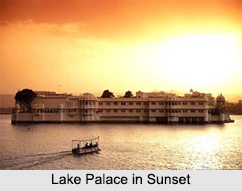 To pray to Surya, the Hindu sun God, the palace was constructed opposite east. At present the palace has been transformed into a heritage hotel. Hence an influence of Mughal architecture can also be seen in the palace. The courtyards of the palace are lined with pillared terraces, columns, gardens and fountains. The rooms of the heritage hotel are decorated with arches and painted mirrors.
To pray to Surya, the Hindu sun God, the palace was constructed opposite east. At present the palace has been transformed into a heritage hotel. Hence an influence of Mughal architecture can also be seen in the palace. The courtyards of the palace are lined with pillared terraces, columns, gardens and fountains. The rooms of the heritage hotel are decorated with arches and painted mirrors.
Re establishment of Lake Palace
Taj Hotels Resorts and Palaces took over administration of the hotel and further another 75 rooms in the year in 1971. One of the key people involved in the restoration, bringing it to such high standards with his work and experience was Jamshyd D. F. Lam of the Taj Group. In 2000, a second re-establishment was undertaken. The "Royal Butlers" in the hotel are offspring of the innovative palace retainers.
The Jag Mandir Palace
Also called the Lake Garden Palace, the Jag Mandir is on an island in Lake Pichola. The construction of the palace is credited to 3 Maharanas of the Sisodia Rajputs of Mewar. The palace was finally completed in 1652 by Maharana Jagat Singh I and it was named as Jagat Mandir in honour of the last named Maharana Jagat Singh. The palace was used by the royal family as a summer resort and has also served as a refuge to asylum seekers on two separate occasions.
The impressive series of structures in the three storied Jag Mandir are the Gul Mahal, which was built first as a refugee for the Mughal prince Khurram. The Gul Mahal has the Garden Courtyard and the Darikhana on its northern side and the Zenana Mahal, which is at its southern extension. The Bara Patharon ka Mahal and the Kunwar Pada ka Mahal are also a part of the Jag Mandir. Then there are the four carved statues of elephants on either side of the jetty entry on the lake from Udaipur, which is the epitome of elegance.
The Shiv Niwas Palace
This ancient Rajput architectural masterpiece used to be the former residence of the Maharana of Udaipur. Located on the southern side of the City Palace complex, the construction of the Shiv Niwas Palace was completed in the beginning of the 20th century by Maharana Fateh Singh. It was used as a royal guesthouse but was later converted into a hotel. The hotel is now run by the HRH Group of Hotels.
The interior of the palace features inlay work of ivory and pearls, the impeccable glass mosaic designs and fresco paintings are the stand out features of the palace. The hotel consists of 36 guest rooms consisting of 19 deluxe rooms, 8 terrace suites, 6 royal suites and 3 imperial suites.
The Fateh Prakash Palace
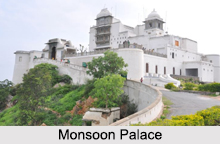 The Palace of Fateh Prakash is located along the shores of Lake Pichola and was built by Maharana Fateh Singh. During his time, a big portion of the palace was converted into a public museum. The museum portrayed the varying tastes of the Rajput kings in the fields of art and culture. The varied sections of the royal museum included the art gallery, archaeology, tribal woodcrafts and weaponry.
The Palace of Fateh Prakash is located along the shores of Lake Pichola and was built by Maharana Fateh Singh. During his time, a big portion of the palace was converted into a public museum. The museum portrayed the varying tastes of the Rajput kings in the fields of art and culture. The varied sections of the royal museum included the art gallery, archaeology, tribal woodcrafts and weaponry.
The Fateh Prakash Palace was later renovated and turned into a heritage hotel under the HRH Group. The palace features distinctive turrets, majestic domes and showcases a treasure-trove of priceless paintings, exquisite chandeliers and a collection of unique crystal and crockery.
The Monsoon Palace:
The Monsoon palace was built by Maharana Sajjan Singh overlooking the Fateh Sagar Lake, to see his ancestral home of Chittaurgarh. It is also known as the Sajjan Garh Palace, located on the Bansdara peak of the Aravalli hill range.
Built with white marble, the palace was made keeping in mind the Rajput architectural style. The palace was planned to be a 9 storied astronomical observatory which would record the arrival of monsoons by keeping track of the monsoon clouds. Despite the beauty of the palace along with its unique rainwater harvesting techniques, the Monsoon Palace was slowly abandoned and has not been renovated as required due to lack of water. Not until very recently, the Monsoon Palace has been opened to the public and has been added to the list of Udaipur"s popular tourist destination.
